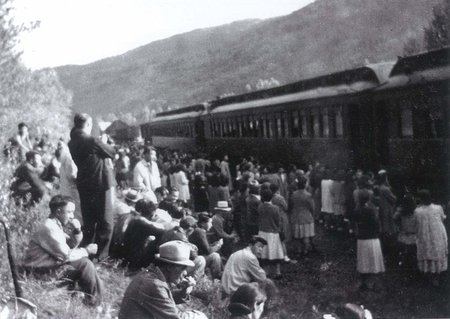As a result of their hard work and community organisations, Japanese Canadians were finally really establishing themselves in Mission, when World War II broke out in 1939. All progress the first (Issei), and second (Nissei) generation made in the hakujin (white) community was interrupted at the out break of the war. Japan officially entered the war with the bombing of Pearl Harbor on December 7 1941. Once this occurred, the Japanese community of Mission experienced increasing anti-Japanese sentiment and rampant racism.
In early 1942, the government ordered all people of Japanese origin residing within 100 miles of the west coast of British Columbia to be removed by force. During the evacuation, they had to leave all homes, businesses, cars, trucks and farming equipment behind. The only items they were permitted to take were their own personal belongings.

Train carrying interned Japanese to Greenwood, B.C.
The majority of Mission’s Japanese Canadians were moved to sugar beet farms in Alberta and Manitoba. The property of 125 families were seized by the government, accounting for 1,274,381 acres of farm land. They were told that their property and assets would be held in trust, and returned to them at the end of the war.
This did not happen. Their property and possessions were all later sold by the Custodian of Enemy Property, at a fraction of their market value. Of particular note: the 80 acre Hashizume farm was sold and Westminster Abbey, a Benedictine monastery that was built on the land. The monastery’s bell tower is now a landmark structure in Mission. The Japanese could not return to the west coast until the ban was lifted in 1949, four years after the war ended. By that time most had established themselves in the interior of B.C., and in the prairies where they were evacuated. Some even resettled in Ontario and Quebec. Many had desired to return, but there was nothing to return to.
A few did return to the west coast, but they did not return to Mission and thus a once thriving community faded into memory.